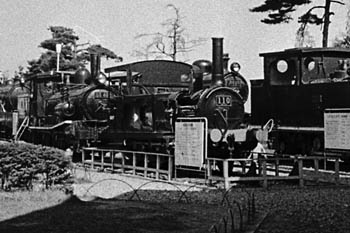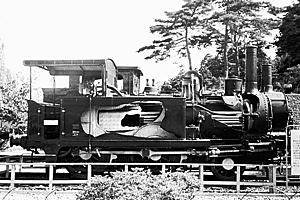Steam Locomotive
| 
Names during the 3 year period 1876-1909 (Photo credit to Railway Museum) |
|
Yorkshire Engine Company's No.10, it's manufactured number was 614.
It would appear that No.10's engine performance was not particularly satisfactory. Christy's report also mentioned that "No.10 was not in very good condition, the more it was checked, the more troubles were found ... No. 10's performance could not be relied upon at all." No.10 gained a bad reputation from Christy. Interestingly enough, No.10 was not greatly remodeled during her life. It would seem that if it's condition was not good.....remodeling would be a natural outcome. Tokyo area's engine numbers were changed to odd numbers during 1876. So, No.10 was changed to No.3. During November 1880, No.3 was moved to Osaka area with No.1, and it was used on the Kobe - Otsu as part of the Tokaido line. During April 1885, it was moved back to the Tokyo area, and was used on the Yamanote line for the Nippon Railway Co. Afterward, it was used for Tokaido line construction. After completion of the Tokaido line, No.3 was returned back to Shinbashi -Yokohama, and it was used for yard works at Shinbashi etc ....
During those days, it was again moved to the Osaka and Nagoya area. No.3 was exhibited during the 50th anniversary of railroads in 1922. Lastly, No.3 (ex-No.10) was retired during December 1923, and was moved to the Omiya works. During WW2, Omiya's exhibition pavilion was burned down by an air raid, but fortunately No.110 escaped the fire. After the war, No.110 remained in a dilapidated condition in the chaos of postwar. During 1951, a small shopping area was built at the Omiya works. This was a set up of a few stands inside of a stationary small train car. No.110 was set ahead of this train. And painted on the left side tank, it read ' Omiya works Train Town Mall '. Afterwards, No.110 was designated a Railway Monument during October 1961. When selecting a historical steam locomotive during the 90th anniversary of railroads in 1962, No.110 was selected because of its historic value. And No.110 (ex-No.10) was improved upon and was preserved in the Ome Railway Park. During 31st August 2019, 110 was moved to the Omiya works to touch up its face-lift for moving to the new JR Sakuragicho-Building from the Ome Railway Park. At that time, an opened right-side view to enable visitors to understand the inner-workings of the steam engine, that dissected part was restored to the original. 110 was displayed to the public from June 27th 2020 with the new building opening. Sakuragicho Railway Station is the former Yokohama station which opened first in Japan with the Shinagawa station on June 12th 1872. (Temporarily opened and formally opened on October 14th 1872.) |





